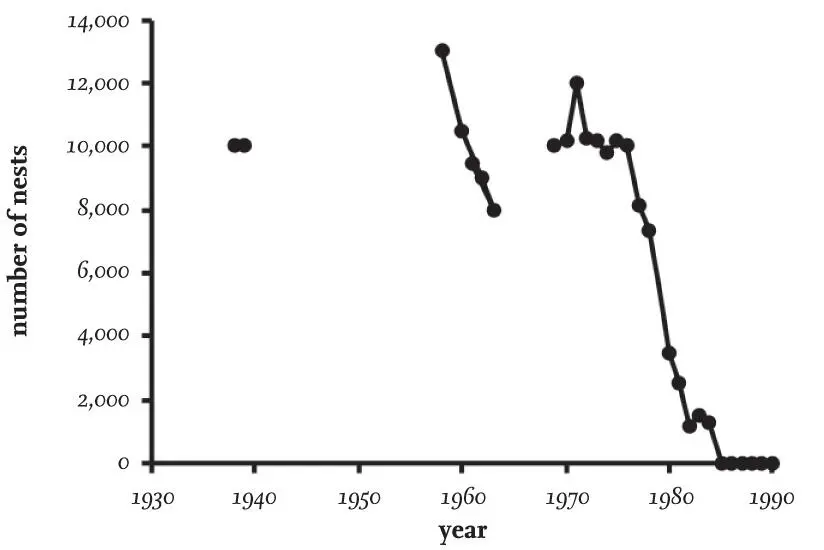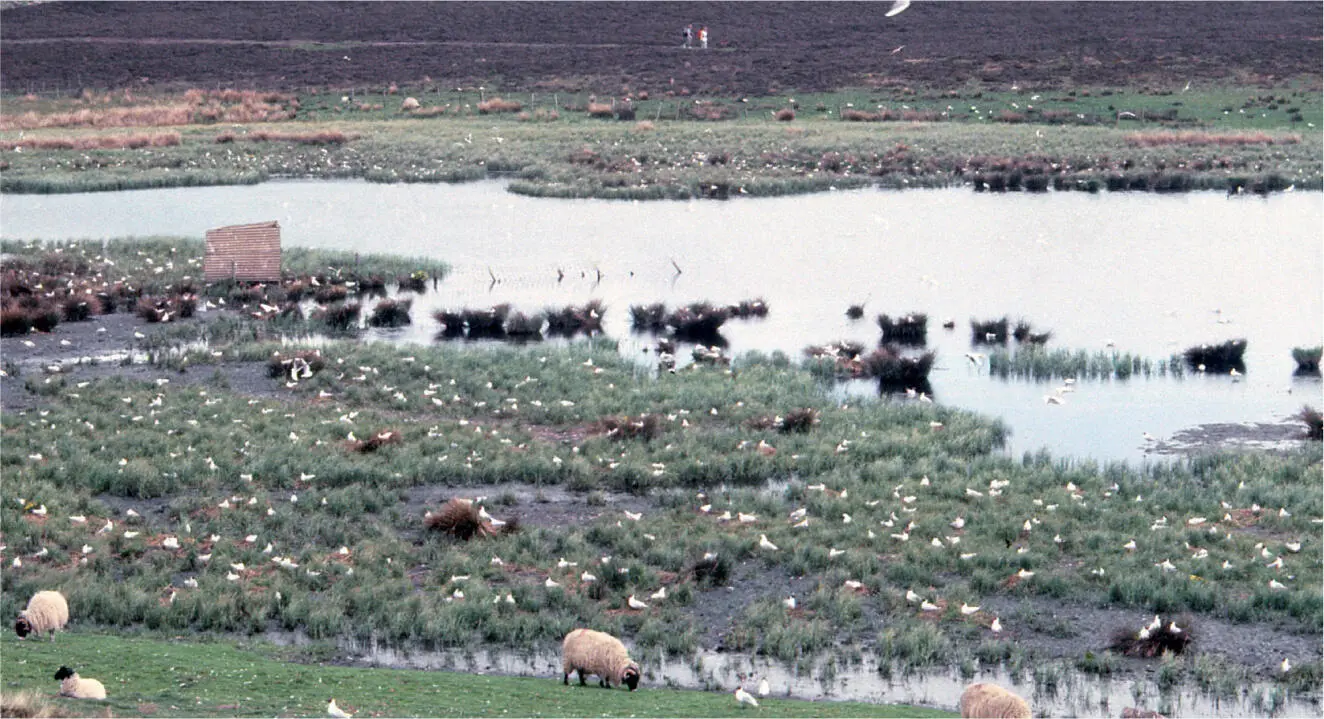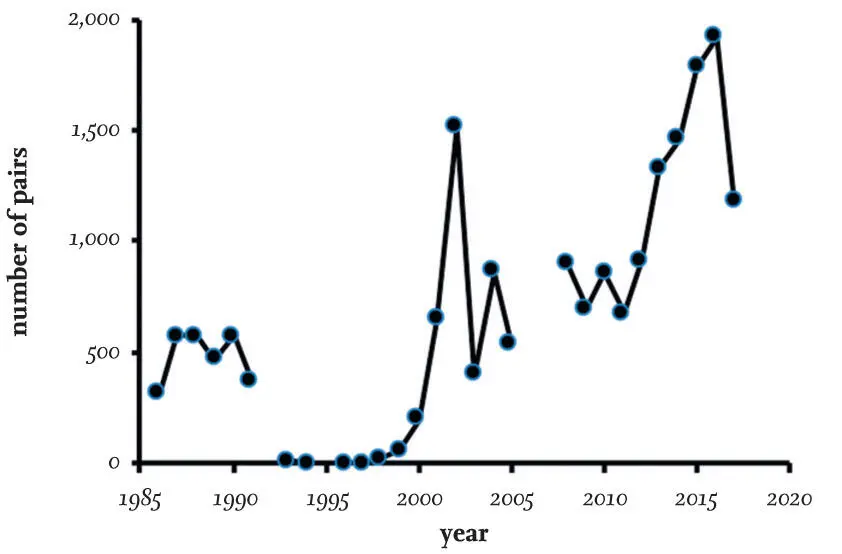Persistence of colonies
While some Black-headed Gull colonies persist for many years, in general they are not as permanent as those of the Kittiwake or Herring Gull (Larus argentatus). Over the past hundred years, many Black-headed Gull colonies have disappeared while new ones have become established. Small colonies are particularly susceptible to decline, and this is especially true of those on upland moors, where the birds nest around small bog pools, reservoirs and lakes. A consequence of this is that some of these mobile groups can be missed during census work.
Various reasons have been suggested for the desertion of colonies. In some cases these are speculative, and include drainage, military activity, competition from increasing numbers of large gulls, aggression by Mute Swans (Cygnus olor) and Canada Geese (Branta canadensis), egg collecting, keepering, and predation by Foxes and American Mink. Rats and Foxes have been a persistent problem for Black-headed Gulls nesting at Blakeney Point in Norfolk, and no young were reared at the colony in 2000. In 2014, Fox predation at the same site resulted in very few chicks being reared by the 2,200 pairs present, while in 2016 an appreciable increase of rats caused the gulls to abandon the colony and, presumably, move elsewhere.
Ravenglass colony
The site of the very large Black-headed Gull colony on the coast of Cumbria at Ravenglass is owned by the Muncaster Estate. There has been continuous collection of eggs there since the seventeenth century, a practice that was recorded as being extensive in 1886. Del Hoyt has suggested the colony had an annual yield of 30,000 eggs over many years. Neither Michael Shrubb’s searches (2013) nor my own have uncovered documentation to confirm or contradict this statement, but the colony was certainly used consistently as a source of freshly laid eggs for much of the twentieth century by the estate, and workers also took some young from time to time. The collection of eggs was well organised and was stopped each year on an agreed date, which left time for successful breeding by birds laying late or with repeated clutches. David Bannerman recorded that the estate collected 72,398 eggs at Ravenglass in 1941 and 24,568 in 1951, when a further 6,000 eggs were taken (presumably illegally) by others.
In 1954, the site was leased to Cumberland County Council as a local nature reserve and egg collecting ceased. The gulls were protected and studied in the ensuing decade by Niko Tinbergen’s research group from Oxford University. During the period 1954–68, the colony size remained between 8,000 and 12,000 pairs, but during this time predation on eggs, chicks and adults occurred from time to time and breeding success was low. In 1968, a full-time warden was appointed, and he reported that 8,100 pairs nested. From then onwards, a marked decline continued each year; Neil Anderson’s study in 1984 found only 1,300 pairs nesting, and the colony was totally deserted in 1985 (Anderson, 1990). Five pairs nested there in 1988 and three pairs in 1989, but none since ( Fig. 20). Predation by mammals over several years, particularly Foxes, was thought to be the cause of decline and ultimate desertion. The abandonment of the Ravenglass colony probably involved a movement of Black-headed Gulls to several other colonies, possibly those in the Ribble Estuary and Sunbiggin Tarn, because no new or established colonies were nearer.

FIG 20. The numbers of nests (pairs) of Black-headed Gulls nesting at Ravenglass in 1939–90.
The history of the Ravenglass colony and other similar sites illustrates two important points. First, egg collecting over many years that was well organised and had an early cut-off had no adverse effects on the colony and did not lead to its desertion. Second, the creation of a nature reserve without effective predator management does not prevent colony desertion; indeed, in recent years there have been other instances of colonies within nature reserves disappearing.
Sunbiggin Tarn colony
The history of the large inland Black-headed Gull colony at Sunbiggin Tarn, near Orton in Cumbria, parallels that of Ravenglass. In 1891, a thousand eggs were said to have been collected from the edge of the colony. The site was estimated to contain 400 pairs in 1938, 1,200 pairs in 1958 and 2,500–3,000 pairs in 1973. The colony continued to grow and reached about 12,500 pairs in 1988 (see below), maintaining similar numbers in 1989, when Foxes were seen. Numbers of gulls then showed a noticeable decline in 1990, and only a few pairs bred in 1991. The colony persisted with a few pairs, and by 2000 had increased to 1,200 pairs, but by 2010 gulls had ceased nesting at the site altogether ( Fig. 21).
Direct counting of all nests proved to be impossible at the large Sunbiggin Tarn colony because of the boggy areas within the tarn and the high vegetation, which would be damaged by trampling during a search for nests. A count of the colony was not obtained for the national census in 1985–87, and in 1988 a novel method was used to measure its size. This involved capturing a large sample of the breeding adults in late May and dyeing their tails yellow. A total of 1,010 adults were captured and marked during two weeks by attracting them with food placed about 1–2 km from the colony and then cannon netting them. When marking was completed, the proportion of dyed birds in the colony was obtained by counts of 4,540 adults passing in and out of the site along flight lines. Of these, 186 – or one in 24.4 – had yellow tails, so multiplying the total number dyed by this proportion (24.4) gave a measure of the total number of breeding birds in the colony. This produced an estimate of 24,644 adults (rounded off to 12,500 pairs), identifying it as the largest inland colony in Britain at the time. Unfortunately, Clare Lloyd et al. (1991), in their book reporting the status of seabirds in Britain and Ireland in 1985–88, erroneously recorded this census as 25,000 pairs of Black-headed Gull, not 25,000 individuals.

FIG 21. Part of the large Black-headed Gull colony at Sunbiggin Tarn, Cumbria, during an exceptionally dry spring in 1984. (John Coulson)
Part of the colony at Sunbiggin Tarn could be viewed by people from the nearby road, and they often fed the gulls, which made attracting and capturing the birds in cannon nets much easier. The public’s interest in the well-being and size of this colony was considerable, and not without humour. The investigators netting adult birds had to explain to onlookers what they were doing and that there would be an explosion when the cannons were discharged. On two occasions, the observers remarked that they were puzzled because they could not find a gull in their field guides with a yellow tail, and asked whether this was a rare species! Members of the public often also liked to guess how many gulls were nesting, generally coming up with figures that were widely lower than the actual numbers calculated – most likely because the extent of the colony could not be viewed from a single vantage point. Incidental to the main study, adults with yellow tails were seen feeding in the Lake District and several places on the river Eden up to 40 km from the colony a few days after marking.

FIG 22. Numbers of Black-headed Gulls nesting on the Sands of Forvie, 1986–2017. Data mainly from the Seabird Colony Register.
Читать дальше















